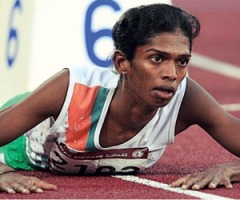This web page was produced as an assignment for Genetics 677, an undergraduate course at UW-Madison.
Summary of "Punishing Difference"

In the express buzz article entitled "Punishing Difference", Vaibhav Saria reveals a saddening case of discimination. Santhi Soundararajan, an internationally accomplished athlete, attempted suicide in 2007 after having her medals taken away. She had tested positive for a Y chromosome. The article then goes on to point out that the extra chromosome conveys no special manifestation of the other sex necessarily. The author also mentions the causes of intersex, inlcuding androgen insensitivity syndrome (AIS).
Saria argues that gender has nothing to do with athletism and discriminates against those who are or identify as intersexual. He concludes with a positive future for Soundararajan. Her local government honors her as an athelete.
Response
I believe the author has a valid point. Gender is a phenotype. Since it is a phenotype, we define it by the most common character state found. For this phenotype, two states exist in majority: male and female. AIS occurs in approximately 1 in 20,000 births and is the most common form of intersex (1). This fact means that little more than .05% of the population exist as unconventionally male or female. However, many of these individuals may never know if they are in that .05%. In the case of AIS, women are usually tested after failing to menstruate, experience unsatisfying sexual activity, etc.; if it is an extremely mild form, they may never know (2). Phenotypically speaking, these individuals can be completely what we define as male or female.
With this in mind, stripping Santhi Soundararajan of her medals defines the phenotype by the Y chromosome alone. However, I believe that such a strict definition is too general.
Figure 1: Symbol for male, female, and intersexual individuals.
Response Continued
Those who wish to discriminate based on gender do so without scientific facts at hand. As pointed out in the article, an extra chromosome or a mutated androgen receptor does not convey any advantage necessarily to a woman. The association of a Y chromosome with increased athleticism ignores the reason for said increase: androgens. More specifically, testosterone is involved in the development of higher musculature and aggression (3, 4). Any female athlete denied her winnings because of a Y chromosome and AIS would be like rejecting a paraplegic from the Special Olympics because he, she, or other has legs.
The author also points out that the unnatural argument is ridiculous. I disagree with his reasoning in the article. The fact is that the international sports leagues do not look fondly on either performance-enhancing or performance-repressing drugs (i.e. Michael Phelps). However, he does have a point arguing against the unnatural argument. Many baseball players have taken many vitamins that increase levels of glucose and creatine in their blood without other natural by-products of ingestion such as fats. This practice is acceptable. Yet it is the use of an unnatural purification/synthesis process in order to improve physicality.
Even given the latter to be perfectly acceptable, the exclusion of intersex individuals is illogical. Sports institutions are claiming that it is cheating to ingest a chemical that unnaturally increases your ability unless it is found in your body but in lower levels. If a woman, who enjoys/identifies as a woman, produces statistically significantly higher levels of testosterone is excluded, then any woman artificially increasing her creatine levels should also be excluded. Both cases are the augmenation of a natural substance occuring in the body.
I conclude as the author, defining the genders through genotype eliminates a small group of people the opportunity to compete. Gender is a phenotype that should not merely be defined by overarching genotype, as in having a Y chromosome or polyploidy or aneuploidy. The specifics of the condition must be considered before defining the phenotype. Even defining the phenotype, however, appears to be irrelevant in this case. Telling an individual that she or he or other cannot compete because of an unfair, inherited advantage appears counter to the goal of events such as the Olympics. The height of human potential is reserved only for males or females in the eyes of the international and national community.
What is gender?
References
1. Galani, A., Kitsiou-Tzeli, S., Sofokleous, C., Kanavakis, E., Kalpini-Mavrou, A. (2008). Androgen insensitivity syndrome: clinical features and molecular defects. HORMONES 7(3). Retrieved from: http://hormones.gr/preview.php?c_id=227
2. Berg, J., French, S., M, L., Kleppe, S., Sutton, V., Gunn, S., Karaviti, L. (2007). Ethical and Legal Implications of Genetic Testing in Androgen Insensitivity Syndrome. The Journal of Pediatrics 150(4). Retrieved from: http://www.sciencedirect.com/science?_ob=ArticleURL&_udi=B6WKR-4N9P3N7-1C&_user=443835&_coverDate=04%2F30%2F2007&_rdoc=1&_fmt=&_orig=search&_sort=d&view=c&_acct=C000020958&_version=1&_urlVersion=0&_userid=443835&md5=e68fa8a63c4dcf070de05f52d943af20
3. MacLean, H., Chiu, W., Notini, A., Axell, A., Davey, R., McManus, J., Ma, C., Plant, D., Lynch, G., Zajac, J. (2008). Impaired skeletal muscle development and function in male, but not female, genomic androgen receptor knockout mice. The FASEB Journal 22. doi: 10.096/fj.08-105726
4. Grgurevic, N., Buedefeld, T., Rissman, E., Tobet, S., Majdic, G. (2008). Aggressive Behaviors in Adult SF-1 Knockout Mice That Are Not Exposed to Gonadal Steriods During Development. Behavioral Neuroscience 122(4). Retrieved from: http://www.pubmedcentral.nih.gov/articlerender.fcgi?artid=2562550
Website authored by Sam Trammell. Email: [email protected]. Last updated: February 11, 2009.

